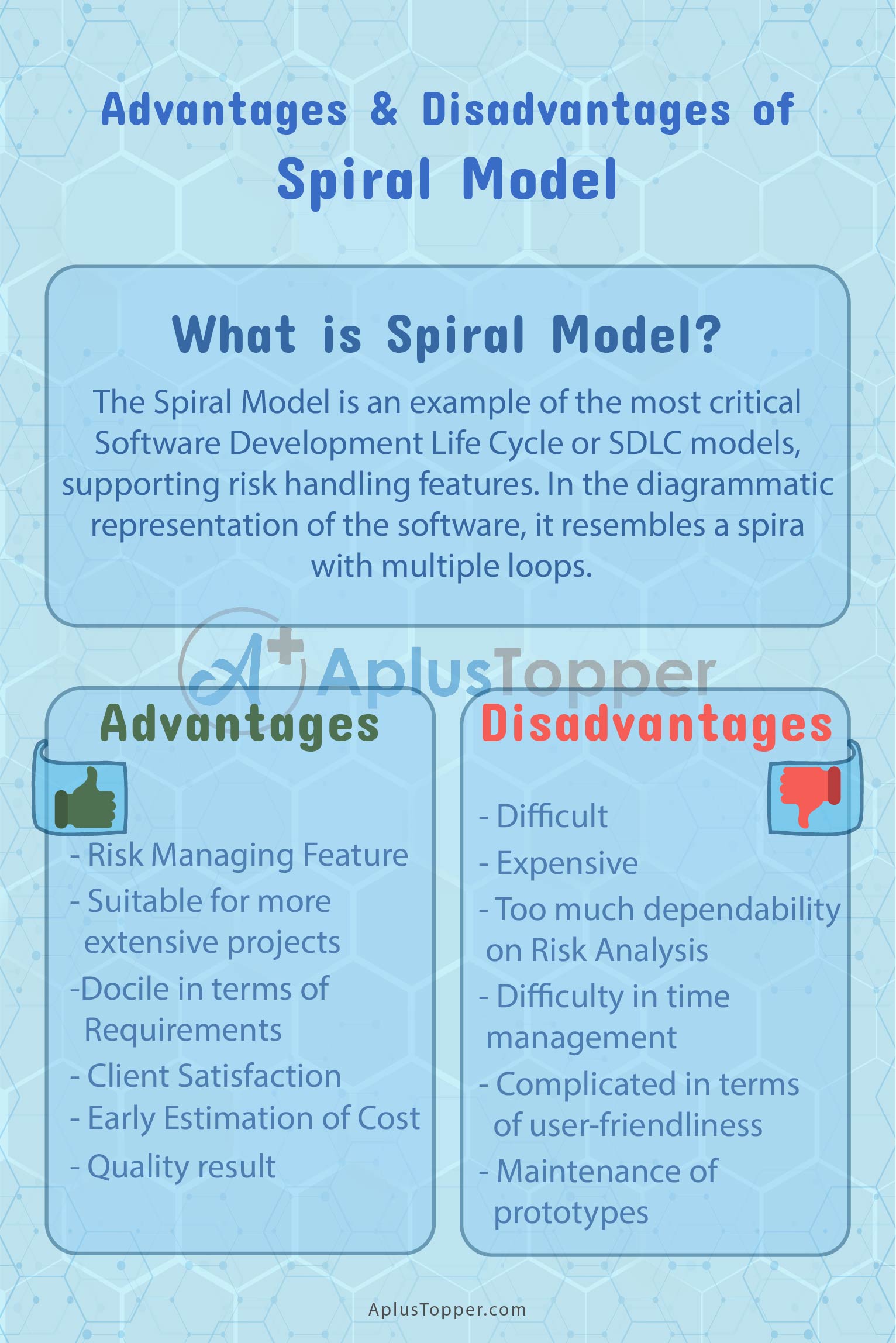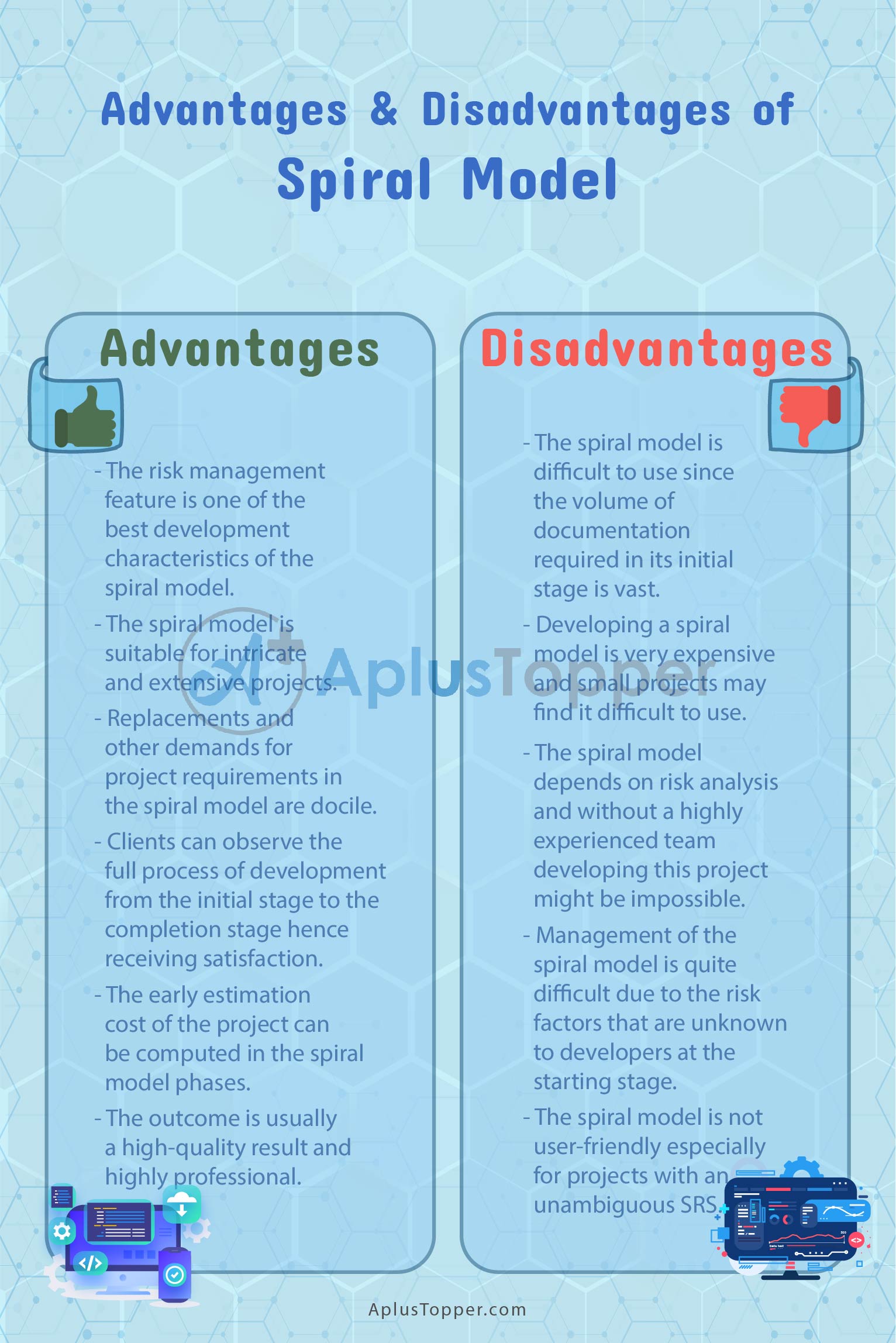Spiral Model Advantages and Disadvantages: SDLC is the short form used for the phrase ‘software development lifecycle.’ It is a framework improvement that organizations implement to the methodical and cost-effective creation of a high-quality software.
Large-scale and small-scale software designing companies utilize the SDLC approach to build solid and efficient software. These organizations obey the development standards that extend from quick-to-lean techniques to ‘waterfall methods’ and such others.
The software development lifecycle or SDLC provides all organizations with a well-organized, step-by-step plan to create successful software from its initial assembling stage to the advanced requirements for a new and innovative product.
The SDLC consists of a range of diverse models, one of which is the famous model called the ‘Spiral Model.’
Boehm originally proposed the spiral model in the year 1986. It is an evolutionary software processing model that links the iterative characteristics of prototyping with the well-coordinated and systematic features of the linear sequential model.
The spiral model is a blend of prototyping and sequential models, which can be best used for extensive projects that involve constant enhancements.
There are some specific actions that are carried out in one iteration or a spiral, where the output is a minute prototype of the whole powerful software. The likewise movements are repeated or iterated for all the spirals continuously till the complete software is finished building.
In other words, Spiral Model is an evolutionary method that aims at the rapid development of added full versions of the software or operation by noting the technical and management perils linked to each level.
This article aims to explain certain aspects of the SDLC Spiral Model.
What is Spiral Model? Advantages and Disadvantages of Spiral Model 2022
The Spiral Model is an example of the most critical Software Development Life Cycle or SDLC models, supporting risk handling features.
In the diagrammatic representation of the software, it resembles a spiral with multiple loops. The specific number of loops of the model’s spiral is undiscovered and is said to vary from scheme to scheme.
The individual loop of each of the spirals is named a ‘Phase’ of the software development process, as mentioned above.
The project manager can modify the actual number of phases required to develop a particular product depending on the project risks. As the project manager determines the number of phases dynamically, the project manager has a vital role to play in improving a product by applying the spiral model.
Each round in the spiral model is classified into four distinct parts
- Setting the intention: Every cycle in the spiral begins with the identification of the target for that cycle.
- Risk Evaluation and Modification: The following step determines the various alternatives to reach the target based on the constraints. The main focus of evaluation in the second stage is based on the risk judgment for the particular project.
- Construction and Validation: The subsequent phase or the third phase is to acquire strategies that help in resolving possible doubts and risks. This process is inclusive of activities like benchmarking, prototyping, and simulation.
- Outlining: The last and final step is outlining the future of the project. The project is evaluated, and various choices are made to proceed with an additional spiral phase. If the outline is determined for project retention, plans are drafted for the next step.

This article seeks to explain in explicit detail the following about the Spiral Model of SDLC:
- Advantages of Spiral Model
- Disadvantages of Spiral Model
- Comparison Table for the Advantages and Disadvantages of Spiral Model
- FAQS on Pros and Cons of Spiral Model
Advantages of Spiral Model
- Risk Managing Feature: The projects including several undiscovered risks that occur with the proceeding development can use Spiral Model in this case since it is the best development model to grasp concerning the risk analysis feature and administration at every phase.
- Suitable for more extensive projects: Using the Spiral Model in long and intricate projects is highly recommended.
- Docile in terms of Requirements: Replacement demands in the project requirements at a much later phase can be included accurately using the Spiral Model.
- Client Satisfaction: Clients can observe the evolution of the product from the early stage of the software development, and thus, get habituated with the method by utilizing it before finishing the entire project.
- Early Estimation of Cost: Project estimations regarding programming, cost, and other factors become more accessible since the project progresses forward in a spiral while reaching completion.
- Quality result: A highly customized outcome with top-quality results can be produced by using the Spiral Model.
Disadvantages of Spiral Model
- Difficult: The volume of documentation needed in intermediate preparation stages makes project management a very difficult task.
- Expensive: Spiral Model is not proper for the development of small projects due to it being very expensive.
- Too much dependability on Risk Analysis: The successful fulfillment of the project is greatly dependent on Risk Analysis, and without highly experienced experts involved in the project, it might result in a failure of project development by using this model.
- Difficulty in time management: In Spiral Model, the number of phases is undiscovered at the beginning of the project, so time management is very challenging.
- Complicated in terms of user-friendliness: The Spiral Model is a complex approach, especially for projects with an unambiguous SRS.
- Maintenance of prototypes: Dictates and protocols should be appropriately followed to perform this model effectively. Doing so through the whole of the project is pretty challenging.
Spiral Model Advantages And Disadvantages In Tabular Form
| Advantages | Disadvantages |
|---|---|
| 1. Risk-driven approach, allowing for early risk identification and mitigation | 1. Can be time-consuming and costly to implement |
| 2. Flexibility in accommodating changes and feedback throughout the development process | 2. Requires experienced and skilled team members |
| 3. Emphasis on user involvement and continuous evaluation throughout the process | 3. May not be suitable for small or straightforward projects |
| 4. Improved communication and collaboration among project stakeholders | 4. Complexity of the model may lead to confusion or misinterpretation |
| 5. Iterative approach leads to more refined and accurate product development | 5. Can be difficult to manage and control due to its flexible nature |
| 6. Effective for large and complex projects with uncertain or changing requirements | 6. Requires strong project management and oversight |
| 7. Provides a structured framework for continuous improvement and learning | 7. May not be suitable for projects with fixed budgets or timelines |
| 8. Promotes early testing and validation of the product or system | 8. Documentation requirements can be extensive and time-consuming |

Comparison Table for Advantages and Disadvantages of Spiral Model
| Advantages | Disadvantages |
| The risk management feature is one of the best development characteristics of the spiral model. | The spiral model is difficult to use since the volume of documentation required in its initial stage is vast. |
| The spiral model is suitable for intricate and extensive projects. | Developing a spiral model is very expensive and small projects may find it difficult to use. |
| Replacements and other demands for project requirements in the spiral model are docile. | The spiral model depends on risk analysis and without a highly experienced team developing this project might be impossible. |
| Clients can observe the full process of development from the initial stage to the completion stage hence receiving satisfaction. | Management of the spiral model is quite difficult due to the risk factors that are unknown to developers at the starting stage. |
| The early estimation cost of the project can be computed in the spiral model phases. | The spiral model is not user-friendly especially for projects with an unambiguous SRS. |
| The outcome is usually a high-quality result and highly professional. | The maintenance of prototypes is very challenging. |

FAQ’S on Pros and Cons of Spiral Model
Question 1.
Why is the Spiral Model also called Meta Model?
Answer:
The Spiral Model is also known as a Meta-Model since it comprises various other models of SDLC. Both the waterfall and prototype models are utilized in Meta Models.
In Spiral Model, software development is done systematically through loops, similar to the waterfall approach. Likewise, a prototype is developed and displayed to the user after the completion of various phases, like in the case of the prototype model. Hence, the risks reduction and systematic approach is the character of the Spiral Model.
Question 2.
Why do developers prefer the Spiral Model?
Answer:
The reasons why developers prefer the Spiral Model are:
- Gives us space for feedbacks directly from customers.
- The principal benefit of the Spiral Model is its risk management feature that saves developers from complexities in the future phase.
Question 3.
What is the function of the Spiral Model?
Answer:
The spiral model is a risk-driven software advancement model. It is based on the unique risk factors of an assigned project, and the spiral model guides developers to adopt elements of various process models, like an incremental, waterfall, or prototyping approach.
